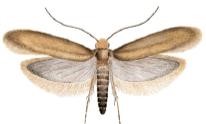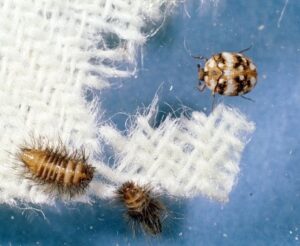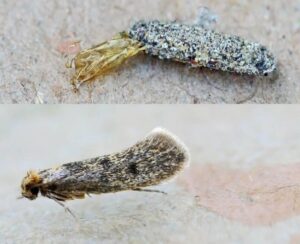Webbing Clothes Moth
General Description
- The body and wings of the adult are uniformly buff in color,
and its head has lightly reddish hairs on top. - The wings are silvery brown to golden tan in color,
without spots, and measure less than 0.7 cm across when extended.
- Adult males are capable of flying, but seldom do so.
- Females are not good fliers, although they can fly for
short distances within homes and elsewhere. - Adults normally live about 15 to 30 days,
and longer in colder weather this time - Larvae are shiny, creamy white in color,
and not more than 1.25 cm long. - Eggs are oval, ivory-colored, and 1 mm long.
Life Cycle and Common Characteristics
- Eggs are laid singly or in small groups among the threads or in the cracks of a suitable food material.
- Eggs are attached to this food material with a gelatinous secretion.
- The female lays 40 to 50 eggs (up to 200), but in the summer, eggs hatch in 4 to 10 days (1 month in the winter).
- Each larva molts up to 10 times during its development.
- The larva then spins a silken pupal case and attaches bits of fiber to the outside of it.
- Length of the pupal stage varies from about 8 to 40 days.
- The entire life cycle may vary from 55 days to four years, but normally between 65 and 90 days.
Damage and Economic & Health Implications
- Adult webbing clothes moths may be found at any time of the year, but are more abundant during the warm summer months. They also develop in heated buildings in the winter.
- Larvae produce randomly placed patches of silken webbing as they move about on the surface of a cloth article they are attacking.
- Webbing is generally sparse in fur, but it may be present at the base of the hairs.




